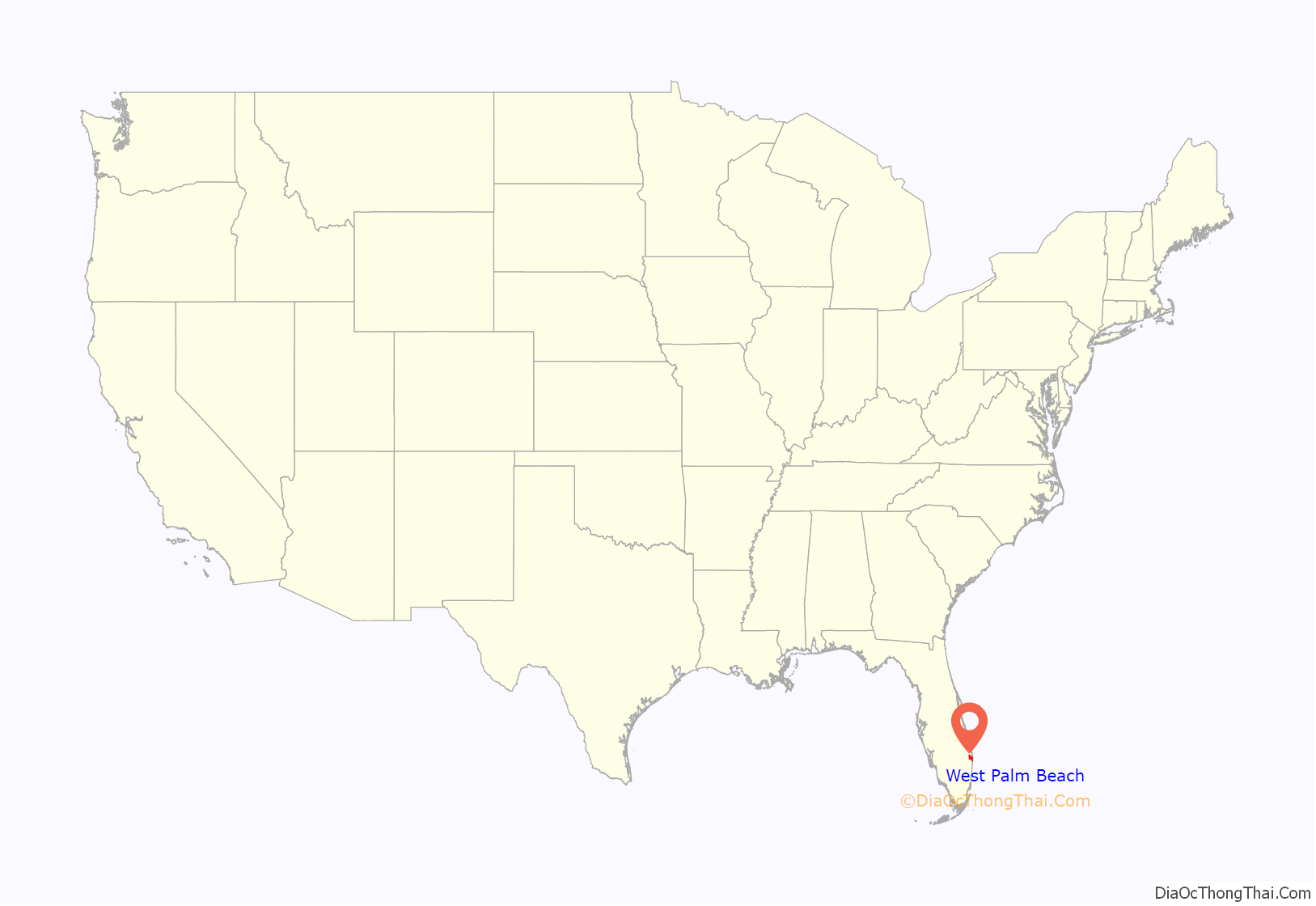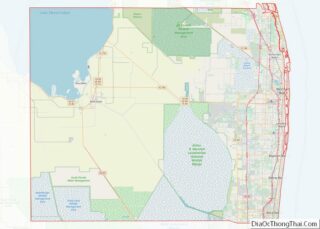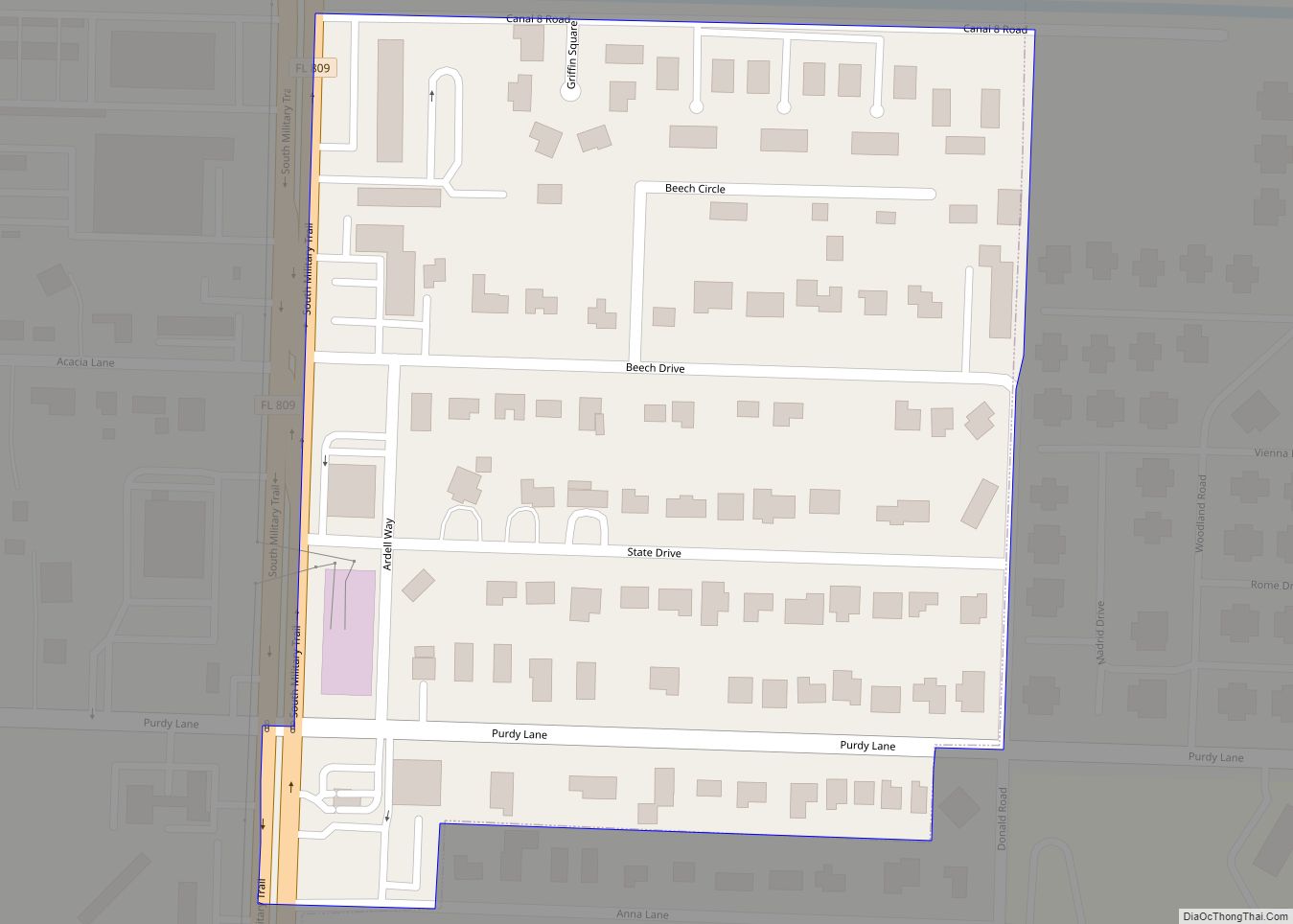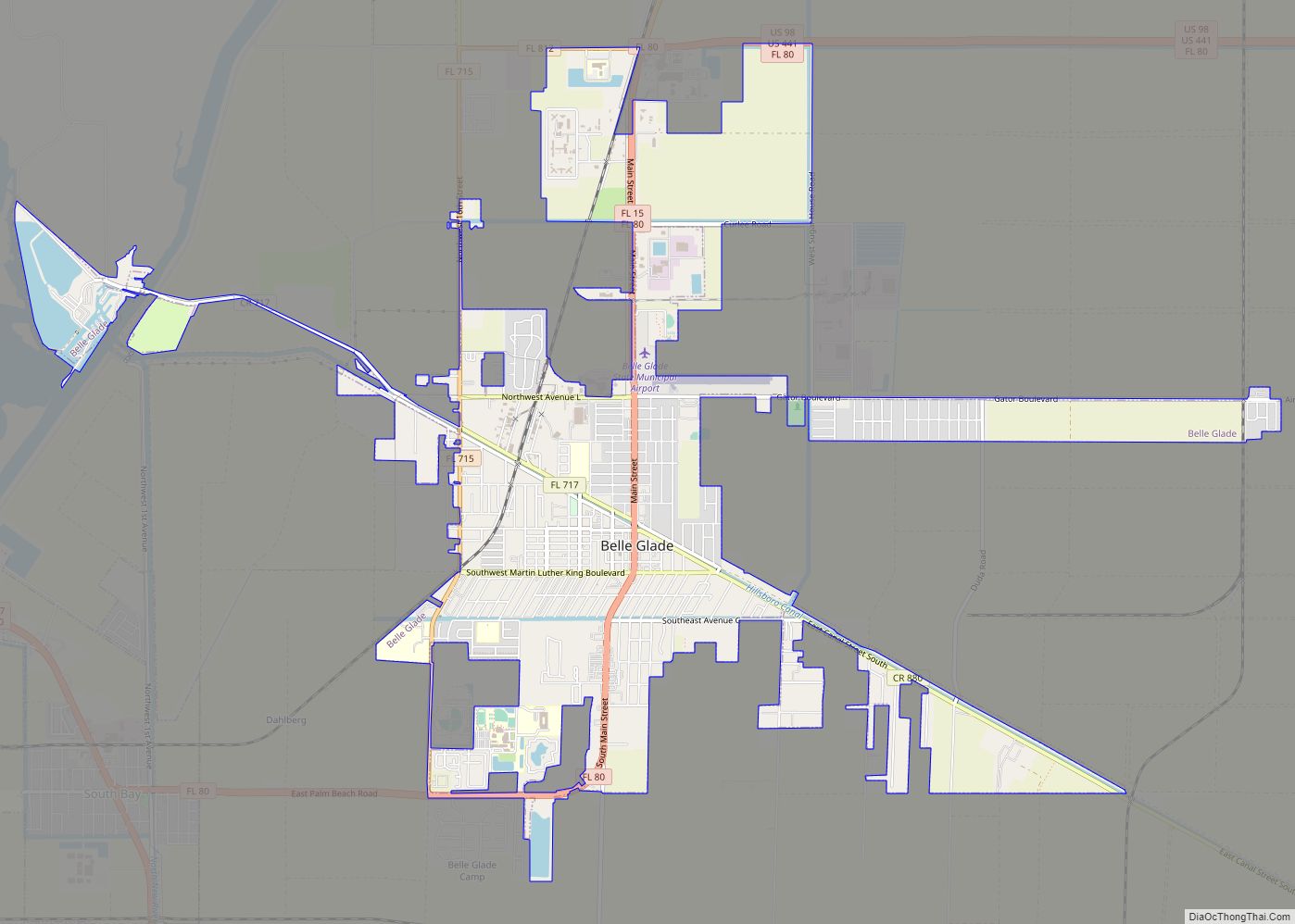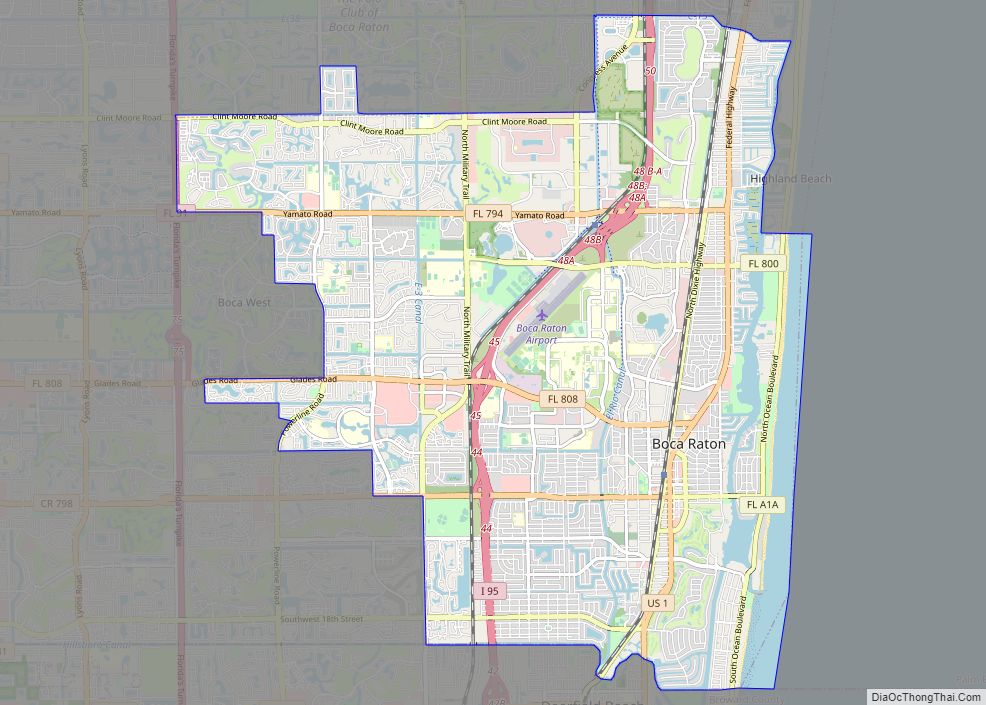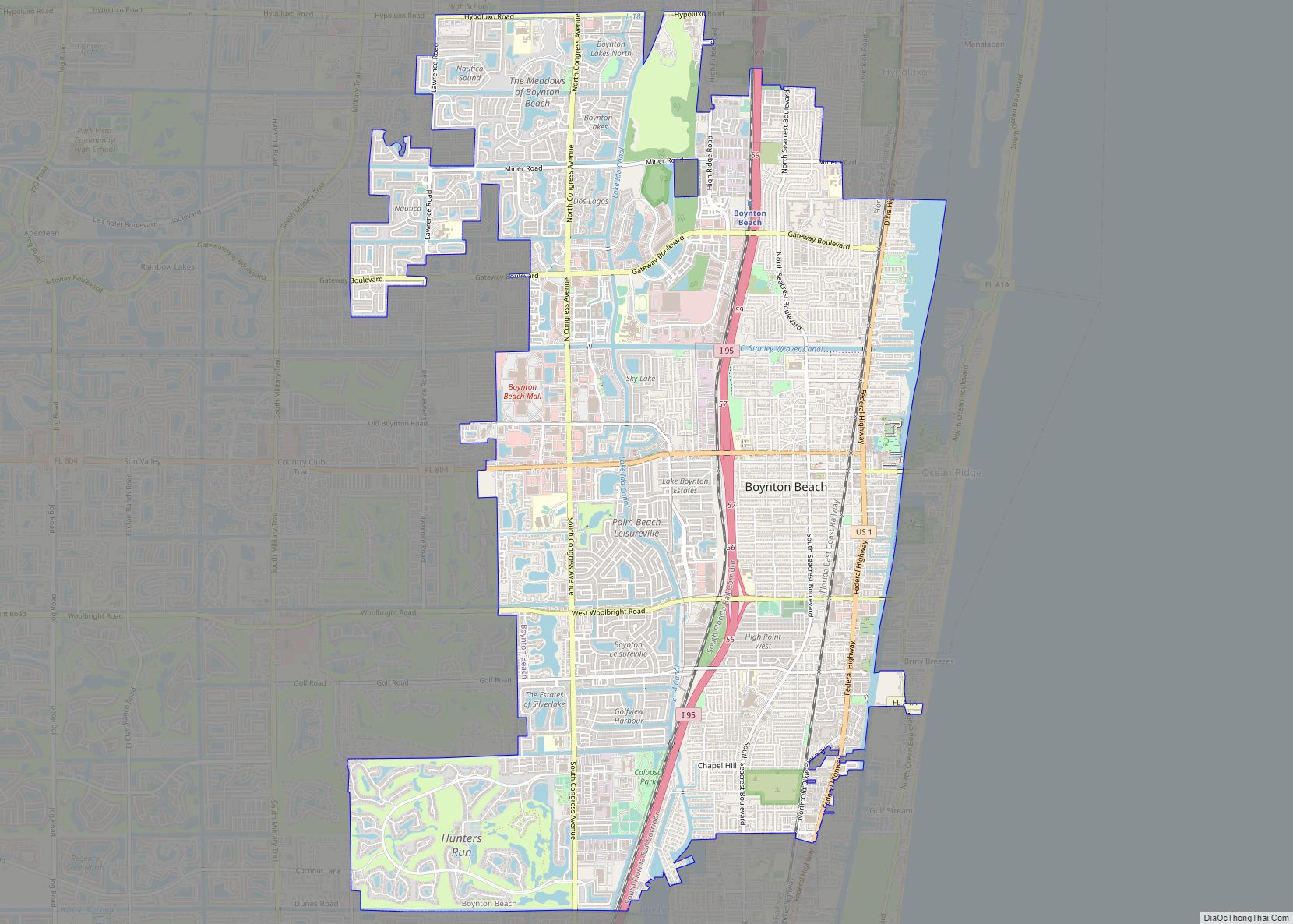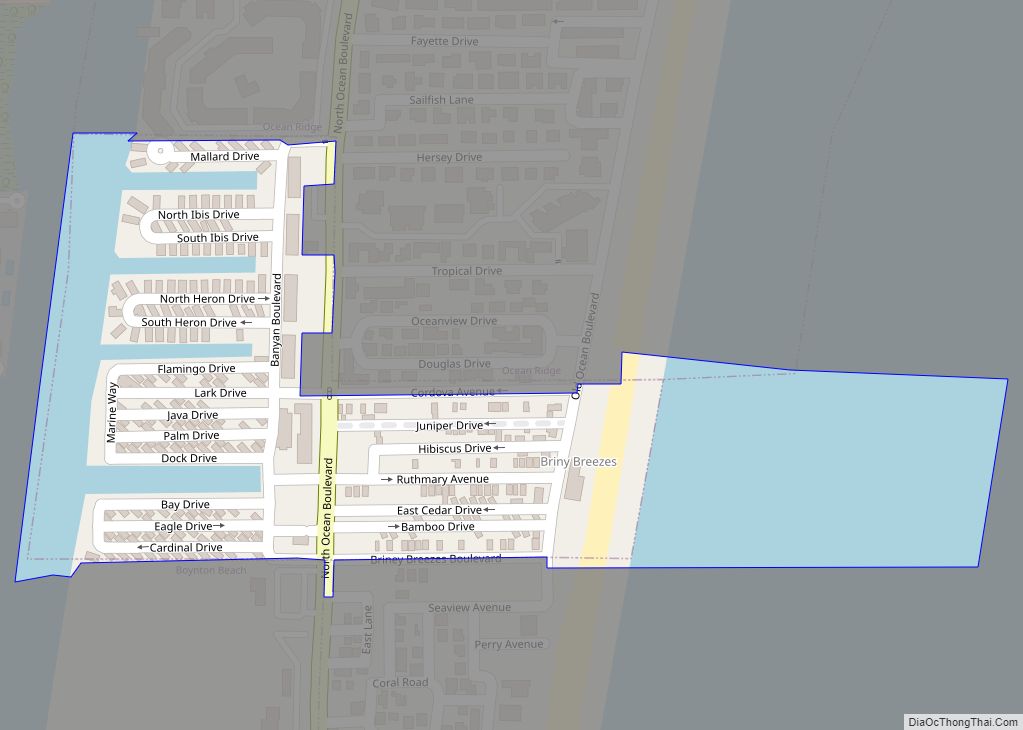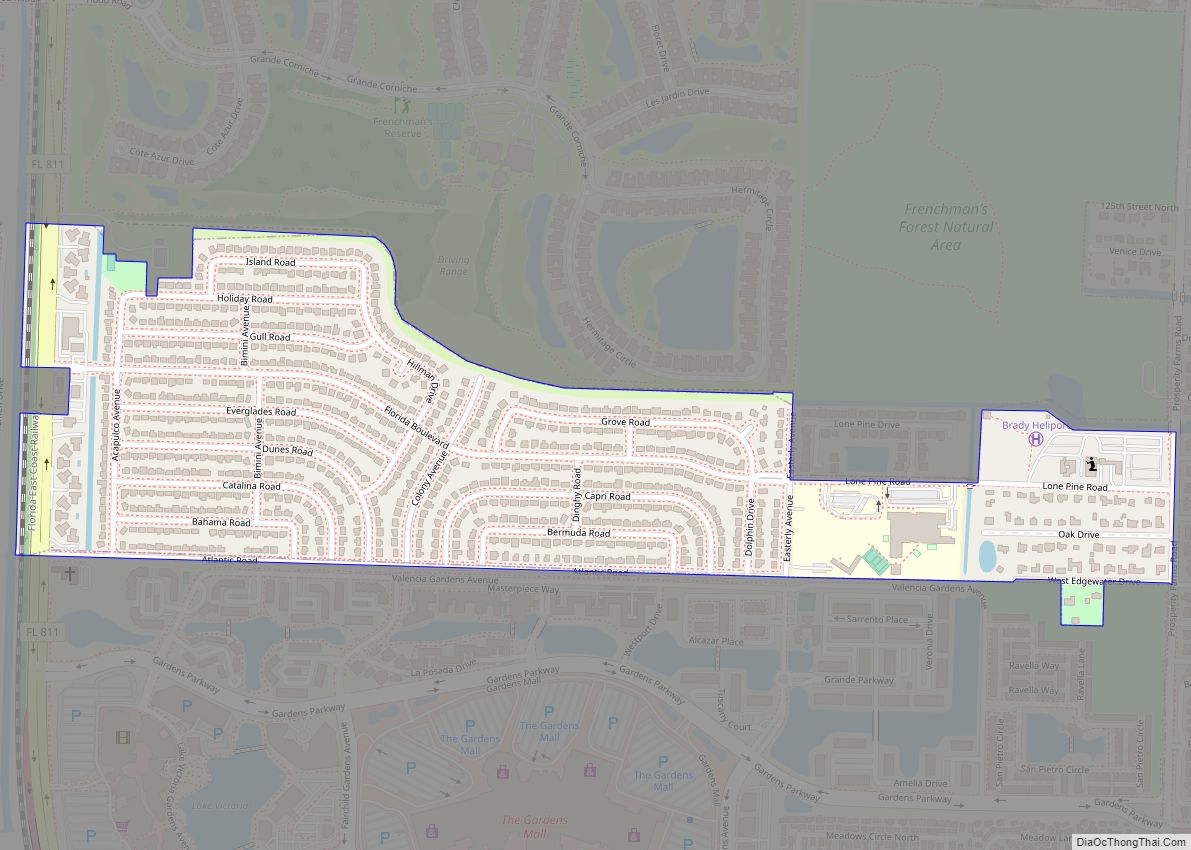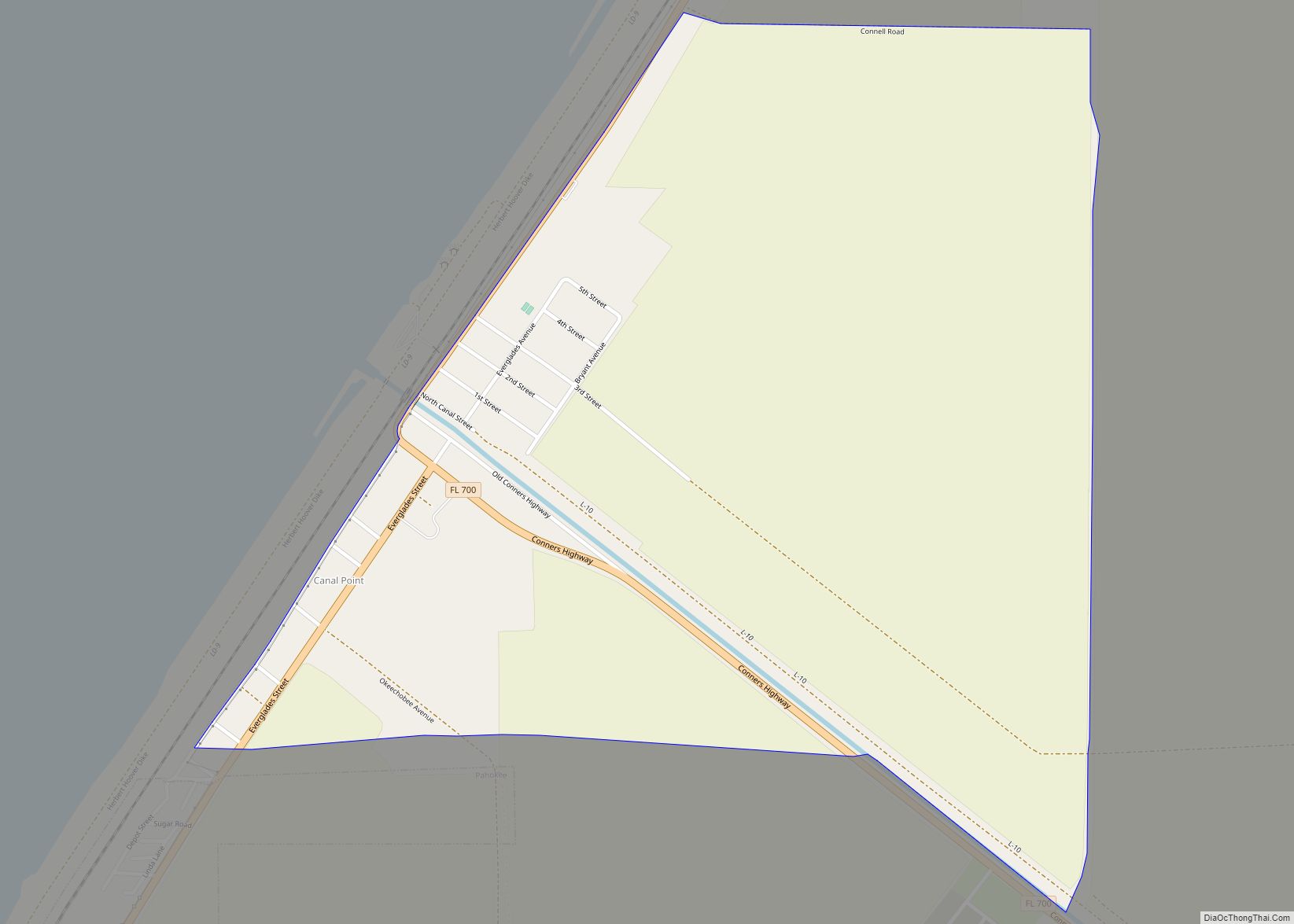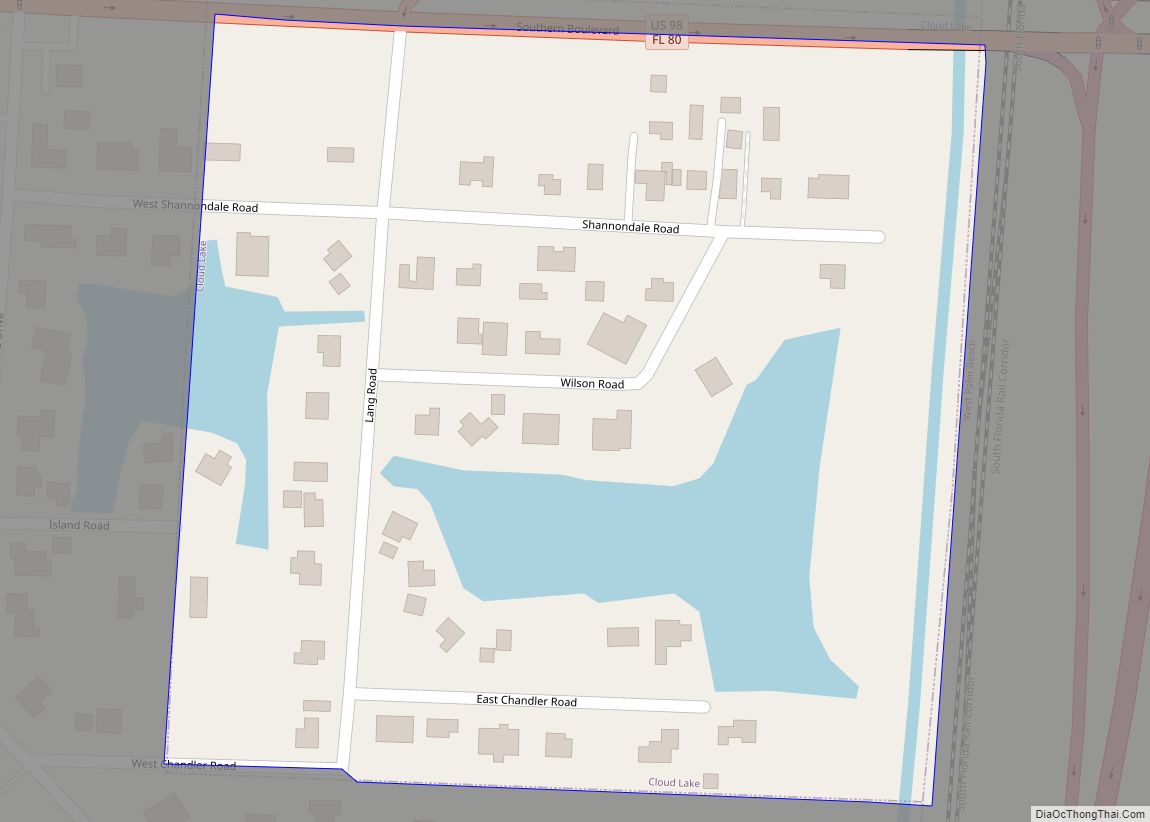| Name: | West Palm Beach city |
|---|---|
| LSAD Code: | 25 |
| LSAD Description: | city (suffix) |
| State: | Florida |
| County: | Palm Beach County |
| Elevation: | 13 ft (4 m) |
| Land Area: | 53.82 sq mi (139.39 km²) |
| Water Area: | 4.17 sq mi (10.79 km²) |
| Population Density: | 2,181.66/sq mi (842.35/km²) |
| ZIP code: | 33401–33422 |
| Area code: | 561 |
| FIPS code: | 1276600 |
| GNISfeature ID: | 0293097 |
| Website: | http://wpb.org |
Online Interactive Map
Click on ![]() to view map in "full screen" mode.
to view map in "full screen" mode.
West Palm Beach location map. Where is West Palm Beach city?
History
The beginning of the historic period in south Florida is marked by Juan Ponce de León’s first contact with native people in 1513. Europeans found a thriving native population, which they categorized into separate tribes: the Mayaimi in the Lake Okeechobee Basin and the Jaega and Ais people in the East Okeechobee area and on the east coast north of the Tequesta. When the Spanish arrived, there were perhaps about 20,000 Native Americans in south Florida. By 1763, when the English gained control of Florida, the native peoples had all but been wiped out through war, enslavement, or European diseases.
Other native peoples from Alabama and Georgia moved into Florida in the early 18th century. They were of varied ancestry, but Europeans called them all “Creeks.” In Florida, they were known as the Seminole and Miccosukee Indians. The Seminoles clashed with American settlers over land and over escaped slaves who found refuge among them. They resisted the government’s efforts to move them to the Indian Territory west of the Mississippi River. Between 1818 and 1858, three wars were fought between Seminoles and the United States government. By 1858, there were very few Seminoles remaining in Florida.
The area that was to become West Palm Beach was settled in the late 1870s and 1880s by a few hundred settlers who called the vicinity “Lake Worth Country.” These settlers were a diverse community from different parts of the United States and the world. They included founding families such as the Potters and the Lainharts, who would go on to become leading members of the business community in the fledgling city. The first white settlers in Palm Beach County lived around Lake Worth, which at the time was an enclosed freshwater lake, named after Colonel William Jenkins Worth, who had fought in the Second Seminole War in Florida in 1842. Most settlers engaged in the growing of tropical fruits and vegetables for shipment to the north via Lake Worth and the Indian River. By 1890, the U.S. Census counted over 200 people settled along Lake Worth in the vicinity of what would become West Palm Beach. The area at this time also boasted a hotel, the “Cocoanut House”, a church, and a post office. The city was platted by Henry Flagler as a community to house the servants working in the two grand hotels on the neighboring island of Palm Beach, across Lake Worth in 1893, coinciding with the arrival of the Florida East Coast railroad. Flagler paid two area settlers, Captain Porter and Louie Hillhouse, a combined sum of $45,000 for the original town’s site, stretching from Clear Lake to Lake Worth.
On November 5, 1894, 78 people met at the “Calaboose” (the first jail and police station located at Clematis St. and Poinsettia, now Dixie Hwy.) and passed the motion to incorporate the Town of West Palm Beach in what was then Dade County (now Miami-Dade County). This made West Palm Beach the first incorporated municipality in Dade County and in South Florida. The town council quickly addressed the building codes and the tents and shanties were replaced by brick, brick veneer, and stone buildings. The city grew steadily during the 1890s and the first two decades of the 20th century, most residents were engaged in the tourist industry and related services or winter vegetable market and tropical fruit trade. In 1909, Palm Beach County was formed by the Florida State Legislature and West Palm Beach became the county seat. In 1916, a new neo-classical courthouse was opened, which has been painstakingly restored back to its original condition and is now used as the local history museum.
The city grew rapidly in the 1920s as part of the Florida land boom. The population of West Palm Beach quadrupled from 1920 to 1927, and all kinds of businesses and public services grew along with it. Many of the city’s landmark structures and preserved neighborhoods were constructed during this period. Originally, Flagler intended for his Florida East Coast Railway to have its terminus in West Palm, but after the area experienced a deep freeze, he chose to extend the railroad to Miami instead.
The land boom was already faltering when city was devastated by the 1928 Okeechobee hurricane. The Depression years of the 1930s were a quiet time for the area, which saw slight population growth and property values lower than during the 1920s. The city only recovered with the onset of World War II, which saw the construction of Palm Beach Air Force Base, which brought thousands of military personnel to the city. The base was vital to the allied war effort, as it provided an excellent training facility and had unparalleled access to North Africa for a North American city. Also during World War II, German U-Boats sank dozens of merchant ships and oil tankers just off the coast of West Palm Beach. Nearby Palm Beach was under blackout conditions to minimize night visibility to German U-boats.
The 1950s saw another boom in population, partly due to the return of many soldiers and airmen who had served in the vicinity during the war. Also, the advent of air conditioning encouraged growth, as year-round living in a tropical climate became more acceptable to northerners. West Palm Beach became one of the nation’s fastest-growing metropolitan areas during the 1950s; the city’s borders spread west of Military Trail and south to Lake Clarke Shores. However, many of the city’s residents still lived within a narrow six-block wide strip from the south to north end. The neighborhoods were strictly segregated between White and African-American populations, a legacy that the city still struggles with today. The primary shopping district remained downtown, centered around Clematis Street.
In the 1960s, Palm Beach County’s first enclosed shopping mall, the Palm Beach Mall, and an indoor arena were completed. These projects led to a brief revival for the city, but in the 1970s and 1980s crime continued to be a serious issue and suburban sprawl continued to drain resources and business away from the old downtown area. By the early 1990s there were very high vacancy rates downtown, and serious levels of urban blight.
Since the 1990s, developments such as CityPlace and the preservation and renovation of 1920s architecture in the nightlife hub of Clematis Street have seen a downtown resurgence in the entertainment and shopping district. The city has also placed emphasis on neighborhood development and revitalization, in historic districts such as Northwood, Flamingo Park, and El Cid. Some neighborhoods still struggle with blight and crime, as well as lowered property values caused by the Great Recession, which hit the region particularly hard. Since the recovery, multiple new developments have been completed. The Palm Beach Mall, located at the Interstate 95/Palm Beach Lakes Boulevard interchange became abandoned as downtown revitalized – the very mall that initiated the original abandonment of the downtown. The mall was then redeveloped into the Palm Beach Fashion Outlets in February 2014. The West Palm Beach station for Brightline, a high speed passenger rail service serving Miami, Fort Lauderdale, and West Palm Beach, was opened in 2018.
Timeline
- 1893
- “Town platted on Lake Worth.”
- Florida East Coast Railway begins operating.
- 1894
- West Palm Beach incorporated.
- John S. Earman becomes mayor.
- 1896 – Fire.
- 1900 – Population: 564.
- 1903 – “City of West Palm Beach” established.
- 1905 – Population: 1,280.
- 1907 – Flagler Park established.
- 1908 – Palm Beach Post newspaper begins publication.
- 1909 – West Palm Beach designated seat of newly created Palm Beach County.
- 1912 – Palm Beach County Fair begins.
- 1916 – County courthouse constructed.
- 1917 – Beaux Arts Theatre in business.
- 1919
- Office of city manager created.
- City Hall built.
- 1923 – Kettler Theatre in business.
- 1924 – Public Library building opens.
- 1925 – Seaboard Air Line Railway begins operating; West Palm Beach station opens.
- 1926
- West Palm Beach Canal (to Lake Okeechobee) constructed.
- September: 1926 Miami hurricane occurs.
- 1928 – September: 1928 Okeechobee hurricane occurs.
- 1930 – Population: 26,610.
- 1933 – Palm Beach Junior College opens.
- 1936
- Morrison Field (airport) begins operating.
- WJNO radio begins broadcasting.
- 1937 – Historical Society of Palm Beach County founded.
- 1941 – Norton Museum of Art established.
- 1942
- April 17: City gets “8.35 inches of rain in just two hours.”
- U.S. military Palm Beach Air Force Base begins operating near West Palm Beach.
- 1947 – WIRK radio begins broadcasting.
- 1948
- Palm Beach International Airport active.
- WEAT radio begins broadcasting.
- 1951 – Beach Drive-In cinema in business.
- 1954 – WPTV (television) begins broadcasting.
- 1955 – WEAT-TV (television) begins broadcasting.
- 1961 – Cardinal Newman High School established.
- 1962 – West Palm Beach Municipal Stadium opens.
- 1964 – Palm Beach County Genealogical Society formed.
- 1967 – Palm Beach County Library System established.
- 1967 – Palm Beach Mall opens.
- 1967 – West Palm Beach Auditorium opens (capacity: 5,000). It would later be sold in 1998 to the Watchtower Bible and Tract Society, Inc (Jehovah’s Witnesses) It was renovated and renamed the West Palm Beach Christian Convention Center.
- 1968 – Palm Beach Atlantic College established.
- 1977 – Snow is reported on January 19 at Palm Beach International Airport from 6:10 a.m. to 8:00 a.m.
- 1979 – Cross County Mall in business.
- 1980 – Population: 63,305.
- 1985 – Plaza hi-rise built.
- 1991
- Yesteryear Village (museum) opens.
- March 12: Strong mayor referendum succeeds.
- November 19: Nancy M. Graham elected first strong mayor of West Palm Beach.
- 1994 – “County Judicial Complex” built.
- 1997 – West Palm Beach Municipal Stadium closes.
- 1999 – Trump International Golf Club in business.
- 2000
- May: Lake Worth Middle School shooting occurs.
- October 27: CityPlace opens
- December 4: Bush v. Palm Beach County Canvassing Board lawsuit decided during the 2000 United States presidential election recount in Florida.
- City website online (approximate date).
- 2010 – Population: 99,919.
- 2011 – Jeri Muoio becomes mayor.
- 2014 – Palm Beach Outlets opens on the former site of the Palm Beach Mall which closed in 2010.
- 2017 – Ballpark of the Palm Beaches opens (renamed FITTEAM Ballpark of the Palm Beaches in 2018)
- 2017 – Lois Frankel becomes U.S. representative for Florida’s 21st congressional district.
West Palm Beach Road Map
West Palm Beach city Satellite Map
Geography
According to the United States Census Bureau, this city has a total area of 58.2 square miles (151 km), of which 55.1 square miles (143 km) is land and 3.1 square miles (8.0 km) (5.26%) is water.
Due to vast areas of wetland immediately to the west of the city’s downtown, growth took place to the north and south in a linear fashion. Until the 1960s, the city was no more than several blocks wide but over 100 blocks in length. Large scale development finally expanded to the west of the city with improved access and drainage in the 1960s. However, the city boundaries were not expanded much with the exception of the “Water Catchment Area”, an uninhabited area in the northwest part of the city. Known as Grassy Waters, it now serves as a reservoir for the city drinking water as well as a nature preserve.
Places
Bel Air Historic District: Developed from 1925 to 1935 as a neighborhood for tradesmen and real estate salesmen who helped develop Palm Beach County, some of Belair was originally a pineapple plantation owned by Richard Hone. Hones’s frame vernacular house, built around 1895, still stands at 211 Plymouth Road. After Hone was murdered in 1902, his property was sold to George Currie, who created Currie Development Co. But before it was developed, the land was sold to William Ohlhaber, who raised coconut palms and ferns. Eventually, Ohlhaber platted the subdivision and sold off lots. The first house built in the subdivision was Ohlhaber’s mission-style home at 205 Pilgrim. Ohlhaber’s grandson said Ohlhaber bought the tract to provide dockage for his 90-foot (27 m) yacht, but the yacht ran aground in the Gulf of Mexico and never reached Lake Worth. In 1947 Hone’s house was bought by Max Brombacher, Henry Flagler’s chief engineer, and it remains in the Brombacher family today. Belair became West Palm Beach’s fourth historic district in August 1993.
Central Park: Central Park is a collective name for several subdivisions north of Southern Boulevard. It originally was part of the Estates of South Palm Beach (which went from Wenonah Place to Pilgrim Road east of Dixie Highway). Like other West Palm Beach neighborhoods, the Estates of South Palm Beach boomed after Henry Flagler’s descent on Palm Beach. In 1884, James W. Copp, a bachelor in the boating business, borrowed $367.20 from Valentine Jones to buy the land. The ownership of what is now known as Central Park changed hands many times before being developed. Around 1919, the tropical wilderness was transformed into an exclusive neighborhood with curbed roads, sidewalks and a pier (at the foot of what is now Southern Boulevard). The neighborhood became part of West Palm Beach in 1926, and was named a city historic district in December 1993. In 1999 the neighborhood was listed in the National Register of Historic Places.
El Cid: Noted for its Mediterranean revival and mission-style homes, El Cid developed in the height of Florida’s real estate boom. In the late 19th century, most of the land north of Sunset Road was pineapple fields, but the crop dwindled in the early 20th century. Pittsburgh socialite Jay Phipps subdivided the old pineapple fields in the 1920s. He named it El Cid, after the celebrated Spanish hero, Rodrigo Díaz de Vivar, who conquered Valencia in 1094. He was called “Cid”, meaning “lord”. El Cid became a city historic district in June 1993. In 1995 the neighborhood was listed in the National Register of Historic Places.
Flamingo Park: Originally a pineapple plantation, Flamingo Park was established by local contractors and developers, who saw the potential in this area—one of the highest coastal ridge sections from downtown West Palm Beach to Miami. Some ridge houses even had ocean views from upper floors. Houses cost about $10,000 to $18,000 in the boom era, and many buyers were owners of shops and businesses on fashionable Dixie Highway nearby. Recently, residents rallied to have stop signs installed throughout the neighborhood and have banded together to ward off commercial and industrial zoning. Property values are rising as residents renovate and restore Spanish-style houses. Most of the homes in the neighborhood, developed from 1921 to 1930, are mission style, but nearly every style is represented. There are many Mediterranean revival-style houses along the high ridge line. Only two buildings in the historic district are known to have been designed by architects: 701 Flamingo Drive designed by Harvey and Clarke, and the Armory Arts Center designed by William Manly King. The neighborhood became a West Palm Beach historic district in January 1993 and was listed in the National Register of Historic Places in 2000.
Grandview Heights: One of the city’s oldest neighborhoods still intact, Grandview Heights was built as an extension of Palm Beach Heights from around 1910 to 1925. Almost all of Palm Beach Heights and half of Grandview Heights was demolished in 1989 to make way for the proposed Downtown/Uptown project, which became CityPlace. Grandview Heights originally attracted construction workers who helped build the luxury hotels, ministers and store owners. The neighborhood has one of the city’s best collection of early craftsman-style bungalows, as well as some modest, Mediterranean revival-style homes. The neighborhood became a West Palm Beach historic district in 1995 and was listed in the National Register of Historic Places in 1999.
Mango Promenade: Mango Promenade became a West Palm Beach historic district in 1995 and was listed in the National Register of Historic Places in 1999. Lies just south of Palm Beach Atlantic University.
Northboro Park: An expansion of Old Northwood, Northboro Park was mostly custom houses for upper-middle-class professionals. Most of the houses are Mediterranean revival, mission and frame vernacular. Developed from 1923 to 1940, the neighborhood became the city’s second historic district (November 1992) and the historic designation may soon expand north to 45th Street. The oldest building in the neighborhood is Northboro Elementary School at 36th Street and Spruce, built in 1925 by DaCamara and Chace. The demolition of Northboro Elementary School began in late 2009. The first home in Northboro Park is 418 36th St., built in 1923.
Northwest: West Palm Beach’s first historic district to be included on the National Register of Historic Places (February 1992), the Northwest neighborhood was first settled in 1894, when the black community was moved from the Styx in Palm Beach to West Palm Beach. It also served as the city’s segregated black community from 1929 to 1960 (along with Pleasant City). Northwest remains a predominantly black community but according to the city planning department, most middle- and upper-class blacks moved to other neighborhoods after desegregation. Tamarind and Rosemary Avenues were the commercial centers for blacks by 1915, but most commercial buildings have been demolished or remodeled so the architecture is no longer significant. There are still good examples of late 19th- and early 20th-century American bungalow/craftsman-style homes in this neighborhood, which also has mission, shotgun, Bahamian vernacular and American Foursquare styles. The Alice Frederick Mickens house, at 801 Fourth St., is listed on the National Register of Historic Places. Mickens was a philanthropist and humanitarian who promoted education for black youth. Another notable house is the Gwen Cherry house at 625 Division Ave. Cherry, Florida’s first black woman legislator and a resident of Miami, inherited the house from relative Mollie Holt, who built the house in 1926. Now it is the Palm Beach County Black Historical Society. The Northwest neighborhood was listed in the National Register of Historic Places in 1992. The next year the neighborhood became a West Palm Beach historic district in 1993.
Old Northwood Historic District: Old Northwood was developed from 1920 to 1927—the height of the city’s real estate boom. The Pinewood Development Co., platted and developed the area. Old Northwood became a neighborhood of what was considered extravagant Mediterranean revival, mission and frame vernacular houses, at $30,000 to $36,000. The buyers were professionals, entrepreneurs and tradesmen. Among them was David F. Dunkle, who was mayor of West Palm Beach. There are houses here designed by notable architects John Volk (best known for his Palm Beach houses), William Manly King (who designed Palm Beach High School and the Armory Arts Center) and Henry Steven Harvey (whose Seaboard Railroad Passenger Station on Tamarind Avenue is listed in the National Register of Historic Places). The neighborhood became a West Palm Beach historic district in 1991 and listed in the National Register of Historic Places in June 1994.
Northwood Hills Historic District: On August 4, 2003, the City Commission designated the Northwood Hills neighborhood as the 13th Historic District in the City of West Palm Beach. Northwood Hills comprises the area from 29th Street on the South to 39th Court on the North. The east side of Windsor is the Western boundary, and Greenwood Avenue is the Eastern boundary. The Neighborhood Association has worked several years to achieve the distinction of historic designation. This is the first district to be designated since 1996. Northwood Hills has a number of Mission Revival houses, a significant collection of Post-World War II architecture, a unique street layout, and one of the highest elevations in the city. The Northwood Hills neighborhood has also elected to allow the establishment of Bed and Breakfast establishments within the neighborhood.
Prospect Park: Promoted as a high-end neighborhood patterned after the prominent Prospect Park district in Brooklyn, this area consisted of mostly smaller estates for prominent businesspeople and northern investors. The neighborhood has a high concentration of Mediterranean revival and Mission revival houses. It was developed from 1920 to 1935 and became a city historic district in November 1993.
West Northwood Historic District: Cashing in on the real estate boom, developers of West Northwood built speculative and custom houses for upper-middle-class professionals from 1925 to ’27. Dominant architectural styles are Mediterranean revival and mission. Although the area was declining, that has reversed in recent years, as more investors buy and restore the houses. West Northwood became a city historic district in August 1993.
The estimated 2012 population of West Palm Beach and the immediately adjacent Census Designated Places is 134,795. Much of this urbanized area lies directly west of the city and includes the neighborhoods of Westgate, Belvedere Homes, Lakeside Green, Century Village, Schall Circle, Lake Belvedere Estates, Plantation Mobile Homes, and Golden Lakes. These neighborhoods are not technically within the boundaries of West Palm Beach, being located in unincorporated Palm Beach County. However, residents possess a “West Palm Beach” address and urban services, such as police, fire, parks, water and sewer, are provided by a combination of Palm Beach County and the City of West Palm Beach in these areas. The City of West Palm Beach also provides water and sewer service to the Town of Palm Beach. The contiguous “urbanized” area, of which West Palm Beach is the core city, includes most of eastern Palm Beach County and has an estimated 2008 population of around 1,250,000.
Key incorporated cities and their populations within the West Palm Beach urbanized area include:
- 89,407 – Boca Raton
- 71,097 – Boynton Beach
- 64,072 – Delray Beach
- 60,202 – Wellington
- 58,298 – Jupiter
- 50,699 – Palm Beach Gardens
- 38,696 – Greenacres
- 36,306 – Royal Palm Beach
- 36,000 – Lake Worth Beach
- 33,263 – Riviera Beach
- 20,872 – Palm Springs
- 12,348 – North Palm Beach
- 10,867 – Lantana
- 8,649 – Palm Beach
- 3,472 – Lake Clarke Shores
- 3,283 – Loxahatchee
- 2,057 – Atlantis
- 1,940 – Haverhill
- 1,939 – Mangonia Park
Notable buildings
Climate
West Palm Beach has a tropical rainforest climate (Köppen Af) with mean temperatures in all months above 64.4 °F (18 °C). The city is situated in USDA hardiness zone 10b, with an annual mean minimum temperature of 37.7 °F (3 °C).
The wet season—May through October—is hot, humid, and wet. The average window for 90 °F (32 °C) temperatures is April 15 through October 10, but temperatures of 100 °F (38 °C) or higher have only occurred four times since record-keeping began in 1888. During this period, more than half of the days bring afternoon thunderstorms and sea breezes that cool the air for the rest of the day. Late in the season, there is also a chance for a tropical storm or hurricane to strike. The area was unusually hard-hit in 2004 and 2005, when Hurricanes Frances, Jeanne and Wilma caused property damage and power outages.
The dry season—November through April—is warm and mostly dry, with 80 °F (27 °C) temperatures remaining fairly commonplace even from December through February. Occasionally, a stronger cold front can lower daytime temperatures to around 57 °F (14 °C), the annual mean minimum max temperature, and lows to around 38 °F (3 °C). Freezes are rare; the most recent was in 2010. The dry season can also bring about potential for drought during hotter, drier seasons.
See also
Map of Florida State and its subdivision:- Alachua
- Baker
- Bay
- Bradford
- Brevard
- Broward
- Calhoun
- Charlotte
- Citrus
- Clay
- Collier
- Columbia
- Desoto
- Dixie
- Duval
- Escambia
- Flagler
- Franklin
- Gadsden
- Gilchrist
- Glades
- Gulf
- Hamilton
- Hardee
- Hendry
- Hernando
- Highlands
- Hillsborough
- Holmes
- Indian River
- Jackson
- Jefferson
- Lafayette
- Lake
- Lee
- Leon
- Levy
- Liberty
- Madison
- Manatee
- Marion
- Martin
- Miami-Dade
- Monroe
- Nassau
- Okaloosa
- Okeechobee
- Orange
- Osceola
- Palm Beach
- Pasco
- Pinellas
- Polk
- Putnam
- Saint Johns
- Saint Lucie
- Santa Rosa
- Sarasota
- Seminole
- Sumter
- Suwannee
- Taylor
- Union
- Volusia
- Wakulla
- Walton
- Washington
- Alabama
- Alaska
- Arizona
- Arkansas
- California
- Colorado
- Connecticut
- Delaware
- District of Columbia
- Florida
- Georgia
- Hawaii
- Idaho
- Illinois
- Indiana
- Iowa
- Kansas
- Kentucky
- Louisiana
- Maine
- Maryland
- Massachusetts
- Michigan
- Minnesota
- Mississippi
- Missouri
- Montana
- Nebraska
- Nevada
- New Hampshire
- New Jersey
- New Mexico
- New York
- North Carolina
- North Dakota
- Ohio
- Oklahoma
- Oregon
- Pennsylvania
- Rhode Island
- South Carolina
- South Dakota
- Tennessee
- Texas
- Utah
- Vermont
- Virginia
- Washington
- West Virginia
- Wisconsin
- Wyoming
